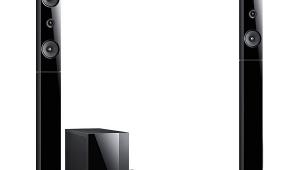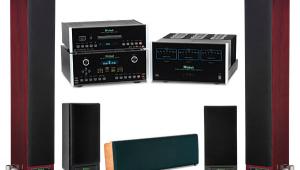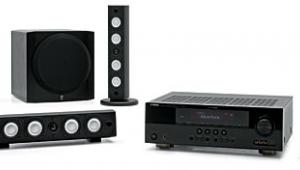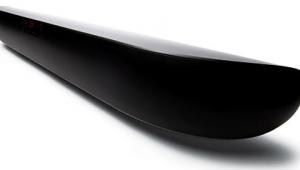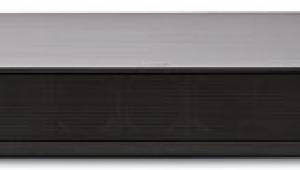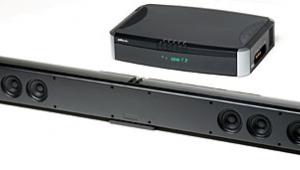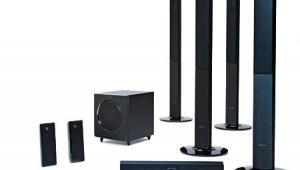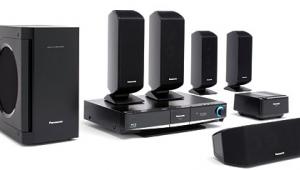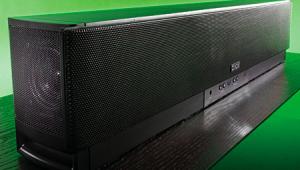At this price point there's really no reason Onkyo couldn't have included the 6 position Audyssey MultEQ calibration complete with subwoofer calibration. With Audyssey you really don't need THX. Audyssey does everything THX does better. I guess that's why Denon has better sound quality at almost any given price point than Onkyo.
Onkyo HT-S9400THX Home Theater in a Box

Home Theater in a Box (HTiB) systems generally cater to the extreme low end of the market, offering complete multichannel speaker and electronics packages (often including a DVD player) for as little as $300. The Onkyo HT-S9400THX is a cut above, offering a highly competent HTiB that is far beyond the all-in-one packages you can drop into a shopping cart at your local Target, though it does not include a disc player.
The heart of the system is the HT-R990 A/V receiver, which is similar to the renowned TX-NR609 reviewed here. The speakers are relatively large for an HTiB—I suspect they are bulked up to impress. While I felt they were the weakest link of the system, I don't imagine that will be a deal breaker for the budget conscious. It's also a simple way to purchase an entire audio system. Moreover, since this is a THX-certified system, you can be assured that the AVR and speakers are properly matched for optimum performance.
Features
As far as I know, this is the only THX I/S Plus-certified HTiB, which includes several THX listening modes for cinema, music, and games. The HTS-S9400THX includes a full-featured HT-R990 AVR, two larger front left and right speakers, a dedicated center (identical to the front left and right in a horizontal orientation), and four smaller, identical side and rear surround speakers. A 10-inch, 125W powered subwoofer completes the package. The AVR includes two additional channels of amplification for speakers in a second room.
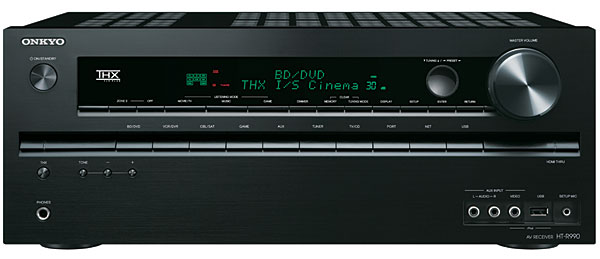
Remarkably, the HT-R990 boasts 4K upsampling with a Marvell Qdeo video processor, a feature now being offered in several Onkyo AVRs. Of course, you need a TV or projector that can handle a 4K signal (actually, 3840x2160 resolution), and there are no such consumer displays except the $25,000 Sony VPL-VW1000ES projector (reviewed here). Of course, it doesn't seem that someone who invests in a 4K display is going to spend $1,100 for their entire audio system. This feature seemed out of place to me here, but it does future-proof the AVR. And the processor upscales any source, digital or analog, to 1080p via HDMI.
The AVR's networking capabilities can stream audio content from a wide variety of online providers and access audio files on a locally networked computer or server; it cannot stream video content. However, while online streaming is available by plugging in an Ethernet cable or using the optional UWF-1 WiFi adaptor, access to files on your computer or server can only be achieved via WiFi. Also, the network-sharing features are compatible only with Windows PCs, Macs running TwonkyMedia, and DLNA servers. (You can also get to your computer files using the VGA port or one of the HDMI inputs, but you'll need to use a separate audio input.) Onkyo didn't send me a WiFi adaptor, so I couldn't test this particular function.
Several popular subscription-based audio-streaming services, such as Sirius XM, last.fm, Napster/Rhapsody, Pandora, Slacker, and Spotify, are available, and Aupeo and vTuner offer a zillion Internet radio stations from around the world that don't require a subscription. MediaFly, which is popular on media streamers, offers several channels of audio content, but no video.
An optional dock is available for playing audio from an iPod or iPhone, though you can save yourself the additional cost and use the front panel's USB port. I used my iPhone with a USB-to-iOS-device connector and was able to navigate through my music with the Onkyo remote while the name of the song was visible on the front-panel LCD and onscreen display. You can plug in USB flash memory or a portable hard drive with all your music, too.
Ergonomics
While the HT-R990 is only available with this specific HTiB system, it physically resembles other Onkyo AVRs. Best of all, it's a full-featured AVR and not a stripped down set of electronics, which is more common with HTiB systems.
The front panel is graced with a large and highly readable LCD display. Underneath the display are various buttons to select surround modes and switch inputs, though it's more likely you'll use the remote for these. A set of analog audio and composite-video inputs are found on the front panel, along with a USB port and a mini plug for the supplied microphone you'll use during setup.

The rear panel has a wide assortment of inputs, but if you're like me and only have HDMI components, you'll appreciate that all the HDMI inputs are located at the top for easy identification and access. I'm especially happy to report that the speaker connectors are binding posts, not spring-loaded clips (except the second-zone speaker outs).
The speakers are small enough to easily carry and install, though the subwoofer seems overly large. The speaker grills are removable and the LCR drivers are set in a D'Appolito array (a tweeter sandwiched between two woofers). The quality of the drivers seems good, but the enclosures appear quite inexpensive. A black faux-wood vinyl covering wraps the MDF enclosures, whose sides extend past the back panel, creating a squared-off cavity at the back of the speaker. This area is just painted, as are the unfinished edges. These basic, old-school, rectangular speaker enclosures lack any sort of industrial design that would be more welcome in modern decors.
I was immediately familiar with the remote, which is exactly the same as the one that came with my reference Onkyo TX-NR609 AVR—even the command codes are the same. The inputs are labeled to correspond with the labels on the rear-panel inputs, though you can change the input assignments in the setup menu. The input buttons are conveniently placed at the top of the remote just under the power button. In the middle are the navigation keys, and next to those is the volume rocker. There are other buttons you can program if you want to control additional devices with this remote.
was immediately familiar with the remote, which is exactly the same as the one that came with my reference Onkyo TX-NR609 AVR—even the command codes are the same. The inputs are labeled to correspond with the labels on the rear-panel inputs, though you can change the input assignments in the setup menu. The input buttons are conveniently placed at the top of the remote just under the power button. In the middle are the navigation keys, and next to those is the volume rocker. There are other buttons you can program if you want to control additional devices with this remote.
Happily, the onscreen display (OSD) is easy to navigate with the remote. Even better, it's available over HDMI, so you don't have to make a second connection to the display just to see the menu.
The HT-R990 is also controllable with the Onkyo Remote App and Remote 2 App for the iPhone, iPod Touch, and Android platforms. However, all devices need to be on the same network, so I was not able to test this. I have the app, but without the WiFi adapter, I couldn't network with the AVR.
Setup
Before you can begin the setup, there is the matter of unpacking the system from a monster box. It's about 50 percent wider than an AVR box, but it's extremely tall and deep. Unless you have a pickup truck or can remove all the seats in your minivan, you'll need to rent a truck to get it home, have it shipped from an online retailer, or unpack the individual components at the store
Despite the large step up in size and performance compared to other HTiB systems, this system has one thing in common with them—the speaker terminals and included speaker wires are color-coded for a faster setup. For anyone who's never installed this type of system, follow the colors and you can't go wrong. I was pleased to see standard binding posts on both the AVR and speaker enclosures, so I used my own Straight Wire cables with banana plug terminations.
- Log in or register to post comments


Kim,
I have spent a couple months trying to setup the channel levels for HT-S9400THX. Audyssey's 2EQ auto calibration did everything wrong: the calibration sequence for the right and left channels was incorrect; the speaker distances came out completely wrong after calibration. Even after changing the calibration sequence the system sounded very inaccurate.
The firmware update from 12/20/2011 has corrected Audyssey's 2EQ auto calibration problems except for the subwoofer calibration. The channel level for subwoofer has come out +7. I had to manually adjust the subwoofer down to -1.
Bottom line: The real problem with this system is not the speakers, but the incorrect calculations for Audyssey's 2EQ auto calibration.
Onkyo HT-S9400THX sounds 4.5 stars after firmware update.

After only owning this for 2.5 years, the receiver failed. Sound output stopped and some of the menus like LAN, firmware upgrade, and Remote Controller were disabled (greyed out). One night it worked great and then the next morning it didn't. To my disappointment, it only had 2 years parts and labour and Onkyo wouldn't do anything. If you google 'HT-R990 no sound' there are other users complaining of the exact same symptoms just after their receiver goes out of service, or coming to that date.
